
The transcript of How Do You Use ChatGPT? with Ben Tossell is below for paying subscribers.
Timestamps
- Introduction: 01:02
- How to use ChatGPT as a business strategist 14:40
- Ben builds an MVP with ChatGPT 23:45
- Use ChatGPT to kickstart your business 41:31
- Ben uses AI to extract valuable information from internet rabbit holes 44:54
- How to turn interview transcripts into compelling articles 54:51
- Ben refines his blog post with Lex 59:34
- Use ChatGPT to analyze business data 1:06:52
- Offload time-consuming tasks to AI 1:09:11
- How AI is enabling people to run profitable businesses with not a lot of resources 1:11:09
Transcript
Dan Shipper (00:00:00)
One thing you’re really good at is starting these one-man profitable internet businesses that are sneakily big.
Ben Tossell (00:00:06)
So Glassdoor is basically an anonymous site for people to leave a review on your employer.So I was like, okay, well, where did that all come from? How did that start? How did they start getting people to write reviews on a site like that? How did Glassdoor get reviews on the site initially? Did they run any incentives? I was looking at that kind of thing. So, things like that. It’s just an interesting way to start exploring an idea and where it’s gonna go and how it changes over time.
Dan Shipper (00:00:32)
One thing I'm seeing you do is when you think about a company that makes a product, the thing that you can see on the internet is sort of the tip of this iceberg, and it's the result of all these decisions and all these processes that a company can do. And if you study the tip pretty closely, you can tell a lot of things about what's underneath the water level that you might not be able to see.
Dan Shipper (00:00:00)
Ben, welcome to the show.
Ben Tossell (00:01:01)
Thank you for having me.
Dan Shipper (00:01:02)
It's great to have you. We've been friends for a while. For people who don't know, you run the Ben's Bites newsletter, which is a daily AI newsletter that I read every day. I love it. I think it's one of the best, if not the best daily AI newsletters in the space.
You also invest in AI companies and you are an exited founder. So, you previously sold a company to Zapier. So you have a ton of experience as a founder and, I think you're also just great at the content media thing. And it's really fun to have you on the show.
Ben Tossell (00:01:33)
I appreciate the kind words and, yeah, it was kind of an accidental content media founder journey, but yeah. That’s what I am.
Dan Shipper (00:01:43)
I just sort of remember. I think this was a year ago, but I just started seeing this guy. Anytime someone would launch an AI demo, there was this guy that would just pop up underneath any one of their projects being like, hey, I just added this to my Ben’s Bites newsletter, you should subscribe. And, I was like, who is that guy?
Ben Tossell (00:02:02)
Yeah. That was another intentional thing that then other AI newsletters started copying as well. And I didn't realize it at the time. Actually, that's what Ryan Hoover did at Product Hunt. And I used to work at Product Hunt before I went and launched Makepad. It was just like, hey, yeah, you should post this on Product Hunt. And then it must have been in my brain somewhere. And I then started realizing that if Sundar from Google is posting something about the Google AI thing, if I could be quick enough to just put my link underneath, it was actually a really good way to start getting subscribers and you reaching the right audience in the right place. So that was a little hack that I didn't intentionally mean to be a hack, but it worked out well and everyone else started doing it. I stopped doing it, but yeah.
Dan Shipper (00:02:54)
That's amazing. Yeah. I'm curious, just high-level. I feel like a year ago was this big hype wave for AI and I think you and me both rode that to a certain extent and got a lot of traffic and a lot of—I don't know—just a lot of good stuff out of that wave. And I think that has started to dissipate, or at least it's changed and we're starting to enter—it's not like you can tweet some demo that you did with GPT-3 and it will just get a thousand likes immediately. We're less in the fancy demo hype phase and more we're actually starting to use this. I'm curious how things have changed for you or what you're thinking about right now in this current era of AI.
Ben Tossell (00:03:43)
Yeah. I mean, on the business side, as a daily AI newsletter. I mean, I started it because there weren't any others. And, at the time, this was like October ‘22, it was pre-ChatGPT. So it was definitely early. And then it was just riding that wave that everyone else was on and seeing anything and covering everything. I want to know everything that's launched and all the new stuff every single day. And then as we've come to sort of now 2024. Even my thinking of this is exhausting to get it out there. It's exhausting for someone who does this as a business to keep up with what's the appetite really like for everyone else consuming this stuff as well, where chat-with-your-PDF product number 57 is a new thing on Product Hunt or Hacker News or or whatever. Are we covering that again? Are we doing that kind of thing again? So, there's a lot of the same stuff. So, we're sort of thinking about that internally. And yeah, we launched Ben's Bites Pro in December where I speak similarly to what you're doing, I guess, where I chat with businesses and CEOs of things how they are using AI in their business and changing their organization and running it on products and stuff. ‘Cause I just think there's not that much out there. There's no Playbook on companies building with AI. And I think it's really interesting. So, yeah, we started doing that and getting some really interesting conversations. But, yeah, I don't know. I don't know what the future holds with all of the daily stuff like this. We always joked about it being just this massive firehose. It still is. And, are people's appetites changing towards, I actually want to know how to use this thing. I don't want, just tell me a new tool every single day.
Dan Shipper (00:05:39)
I feel that. I mean, I just love how bored you sounded talking about the next PDF tool. Number 57.
Ben Tossell (00:05:50)
I mean, again, this still goes back to my Product Hunt days. I was a community manager. It was my job to have companies be on the homepage and support their launches and also get in the comments and start people talking about it. And then I got to a point where it was probably a similar timeframe where I was like, this is another dating app. This is another weather app. Why do we need this? What's the point of this? There are so many others and maybe I haven't changed all that much since then, I guess, but I think it's just, I like seeing new things. I like seeing things that are different, or there's a reason behind doing this other than, oh, I've just done the same kind of thing as everyone else, it's slightly different because of this one thing. But equally, you see all these PDF products. There's plenty of them. You can do it in ChatGPT. And then there's companies like PDF AI making, I don't know, $200,000 monthly recurring revenue from just focusing on that one thing. So it's definitely a bias between, I'm seeing all of this stuff, other people are seeing maybe that one ad for that one tool and signing up and using it and finding it useful so yeah, that's why I'm biased. I'm jaded by it, I guess.
Dan Shipper (00:07:10)
No, that makes perfect sense. I mean, I think we're both sort of in pursuit of what is genuinely interesting. And I think we both have moved from any new AI demo is interesting into, how are people actually using it? And I think that's definitely the concept of this show is there's so much latent hype or latent energy around ChatGPT—people just feel like they should be using it, but not enough people actually know how, because it's such a general tool and there's so many different ways you can use it. And even just remembering to use it is kind of hard. And so, yeah, I feel we're sort of on the same wavelength there, giving people the real ways that you use it, or I use it, or lots of other smart people use it is the most valuable thing you can do at this point in the AI wave.
Ben Tossell (00:08:02)
Yeah. And I think that so many people come in with a question, get an answer. And they think that's what ChatGPT is. And I still do this today where I will do that multiple times a day and think, oh, I didn't do all these other tips and tricks and ways I can get sort of a better outcome. Sometimes you don't need that, but I think knowing that you have that there and then after sort of practicing unintentionally some of these tricks or whatever you'd call them, over time, you start recognizing that okay, that's a good way to get a good response from something. I think I've learned some from this podcast. I think Sahil showed just regenerating a bunch of stuff and then just going through the answers like, okay, yeah, I know how to do that. I just think, if there's an error, do that, but it's not really for that.
So, yeah, there's so many different ways people can use it, and it's one of those tools that I intentionally think of if I've got something that I'm going to search, which AI tool am I going to use first? And, should I use AI for this? And I don't know whether my appetite for, okay, I know it might take me a few minutes to go and do this on ChatGPT, on Perplexity, wherever, versus go to Google and do the work myself.
I'd rather be sitting there doing the lazy work of prompting and asking and figuring out whether the answer was what I wanted rather than feeling like I'm doing the work, going through the blue links, going through the lists of lists of lists to then be like, I'm still not where I was trying to get to so I'm just using it for everything small and bigger at every moment of the day, I'm just always trying to default towards, let's use AI for this somehow.
Dan Shipper (00:09:59)
Yeah, me too. I mean, one of the recurring ideas on this show is, I think, starting to think of yourself as a model manager rather than an individual contributor is a really powerful idea. Specifically, I think that helps in two ways. One is it avoids the problem that people have where they try one thing and then they're like, oh, it didn't work or, it's not good enough or whatever because if you're thinking of yourself as a manager, one of the skills of a good manager is to know what the employee that they're managing is good at and how to get the best out of them. And so I think that transfers very strongly onto AI. It's your job as the model manager to know what it's good for and to know how to get the best out of it and to feel like you will get out what you put in. And so I think it's super important for that.
And it's also super important, you're talking about defaulting to not having to click through all the blue links and stuff like that.Yeah, that's sort of what a manager does. You're not necessarily in all the details all the time, but you can go in there sometimes if you need to. But being in that place is, I think, a little bit more of a management headspace than it is an individual contributor headspace. And I think that's really cool.
Ben Tossell (00:11:13)
When you wrote that piece and you sent it to me, I think I said something like, yeah, but I don't like being a manager. I don't want to be a manager. I can't ever think of myself like that. Well, I'm going to say, I'm pretty sure I wasn't a good manager when I ran my company. And it kind of feels like—I don't know—I'm trying to do whatever this thing is now. Maybe I don't want to call it a model manager, but you are learning similar things. Like you said, it's which tool is best for this thing versus I'm just going to default to ChatGPT for everything. Actually it didn't give me the right thing. Did I ask it the right thing to give me the right thing back? And you do have to think like that, but I'm certainly not thinking of myself like a manager. Maybe it's a branding problem, but yeah.
Dan Shipper (00:12:05)
Maybe I have to rebrand it, but I'm sticking with manager ‘cause I like being a manager.
Cool. Well, I guess on that note, I would love to just get into this sort of show-and-tell portion. I know you have a bunch of stuff to show me about how you use ChatGPT. And then I think we're going to broaden into other AI tools, which I'm actually quite excited for. And the first one, it sounds like you're using ChatGPT to do research on companies. So to set it up, tell me a little bit about what kind of company research you're doing and why you would want to use ChatGPT for that.
Ben Tossell (00:12:39)
Yeah, I mean, I'm just trying to scroll to find it because it’s so far back. So, I'm just obsessed with business ideas. Always have been. It took me 50-plus ideas to get to Makepad which is the one thing that worked.
Dan Shipper (00:12:54)
Your last company.
Ben Tossell (00:12:55)
Yeah. So that's the one thing that worked and that was a byproduct of all the other things that didn't work because I was building them with no code. So I built a way, those who can't do, teach. So I told people I'd do that same thing. And then, with Ben's Bites, we cover a lot of interesting products, a lot of interesting news, you see trends, you see how people are using stuff and all that. And, I don't know, I just can't help but think, that's really interesting.
What if that was that for something else? I think most people think of startups as get on TechCrunch, get funding from YC and sort of shoot for the moon kind thing where they're never the kind of businesses I’ve—I don't say I wanted to build, I wanted to build them before I started building Makepad and then realized I just like this kind of business. Bootstrapped, took angel round, but I'm not looking for a billion-dollar outcome, probably because of the manager thing. I don't wanna be a manager of a 300,000-person company. But it's hard.
And I think that the lifestyle branding on those businesses has ruined it a bit because okay, who doesn't want a $2 million year lifestyle business? That sounds great. So just think of products in terms of this company is doing this thing really interestingly, is there a space that this for X, Y, Z could be done similarly. Really, if you look at lots of businesses, all the business models, all the ways that they do business, are often pretty straightforward. You can see, okay, they do this thing, then this thing, then this thing. So it's just, for me, I like to throw businesses in there. I'd be like, what's a similar kind of business to this? And where else would this kind of thing be useful? How would you think about building that kind of company? That kind of chat is what I like to do, so I put up a couple here. I'll share my screen now.
So this was a chat I had with ChatGPT about a product called Yardstiq from the company CB insights. So they put together a bunch of valuation data, funding, fundraising. interesting things like that. But I think the product is tens of thousands of dollars a year to access. I'm not paying that. They have this spinoff product called Yardstiq about what software buyers really think about their vendors. And it's effectively from what I've analyzed, I suppose, is they go to Fortune 500 companies and say, what are you using for X? And then they’ll have a transcript, they record their conversations, and then if you're a fellow sort of buyer in that market, you're going to spend tens of thousands on a new product. You want to know about the integration, you want to know the pricing, you want to know what the customer support was like, you want to know what the onboarding was like. Look at other companies similar to yours, and sort of determine whether you're going to go down that road. So, they have just on the landing page, it says, “Enter a business email address, get a free trial.” And it just has a bunch of testimonials, essentially. It's effectively a very small snippet from the transcripts that they have. So, for example, I'm showing this one about Snowflake. “The economics of Snowflake give a huge advantage. Instead of spending $15 million, we decided we could at least probably save 70 percent in terms of the cost that we were expending on Teradata if we went with Snowflake.”
So something like that is good to know if you're going to be spending millions on doing one thing with one vendor, and you could be looking at another. So they've got a bunch of different companies here, but there's not much else on this landing page. And, again, I can't pay the thousands of dollars to go and sign up for this. So, I think I did some Google searches of Yardstiq product images. I looked back on some of the tweets from the CEO where they shared some screenshots here, there, and everywhere. And then this was one of the screenshots where it shows, okay, this is a Forta customer, a head of fraud at a $1 billion valuation startup. So they don't give you any identifying information. They sort of give you a highlight of the customer, their head of fraud; company, again, billion-dollar valuation startup; the role, key decision maker; purchase details, purchased on in Q3 2018; purchase amount, $250,000 a year; and, then it's got this transcript underneath, which, I assume as a customer, you could go and read. So it has subject subsections, introductions, evaluation, structure, solution, specific sales experience, deployment, competitors, pricing and packaging, post-deployment. And you can sort of see a small snippet again of one of those transcripts. So I thought, that's really interesting. I wonder if I could throw that into ChatGPT using image search and saying, what’s in this image? And that's literally how I started the conversation.
Dan Shipper (00:18:38)
That's interesting. I want to stop you there. So, you're coming across a website and the website is for a product that CB Insights is selling and you're curious about it. Are you curious about it from the perspective of what we were talking about earlier where you're thinking about, okay, could I build a product like this in a different category or, what's your curiosity? What are you trying to find out?
Ben Tossell (00:19:03)
I think there's probably a few: One is CB Insights is notoriously—well, they've got a lot of revenue. They've talked about it on podcasts. They have big customers who spend tens of thousands on this data as a product, and I'm pretty fascinated with data products as they are. I think it feels to me that you could build one or build versions of them with a one-person company, and you could get to $500,000 a year as a one-person company building some sort of database product in a specific niche.
The part of my curiosity is, what are the best of the best doing in this space? And then, if I boiled out that, if I sort of simmered that down to a simplified version for a different space or a different category, how would I go about doing that? And then, yeah, I just think it's kind of interesting to peek behind the scenes of enterprise companies that you can't ever see without jumping on the call with the sales rep, doing the free trials, all of that kind of stuff. And you just want to know if you're paying $30,000 a year, or whatever it is, what does a product like that look like on the inside? And to me, it looks like, hey, here's a transcript that we created with someone, we did the work to interview them, we've anonymized some of the data, here it is. And also we found many others like them. And obviously CB Insights has lots of other research and reports and data that they pull together through machine learning and human analysts. But, if you cut all of that away and you just said, I want to build something where I interview people and I sell access to these transcripts, what could that look like? That, I think, could be a business itself.
Dan Shipper (00:21:07)
That's amazing. Okay, I think I get it. And so, one thing that's happening or one thing I'm seeing you do is when you think about a company that makes a product, the thing that you can see on the internet is sort of the tip of this iceberg, and it's the result of all these decisions and all these processes that a company can do. And if you study the tip pretty closely, you can tell a lot of things about what's underneath the water level that you might not be able to see. And then you can use that to figure out, okay, what do I wanna build if I wanna do something like this? And it sounds like you're using ChatGPT to do a little bit of that investigation. You're gathering some starting data and then you're using ChatGPT to figure out, okay, what's under the surface here? What am I seeing? How is it constructed? All that kind of stuff. Is that right?
Ben Tossell (00:21:05)
Yeah, definitely. Because I think you can sort of make assumptions on what work is needed under that sort of tip to get to the point where you have something that you could sell and this could be a product. And this is something that people would pay for because you hear lots of companies that are tens of thousands of employees and all the rest of it. And there's lots of work that goes into whatever they put out. And I just think if you can see, what does the output look like? And you can figure out a way to get there or a way to get part of the way there, carving out a very small part of whatever they're doing. And it becomes less scary to be like, I could never start a business like whatever that charges whatever to these kinds of people where I just think it makes business less daunting to think about in those terms of— I do believe that anyone can build most things, not big VC-funded companies, but most things to get a great multi million-a-year lifestyle business. And I think even with AI, we're seeing lots of that now where lots of individuals and small teams are building really, really valuable companies that aren't venture backable, nor should they be, but it's still a great business. There's a really simple equation that goes into what does it take to build something that provides something valuable to customers that we can get thousands or tens of thousands of customers signing up for this and paying us.
Dan Shipper (00:23:33)
I love that. I love that and so now I think I kind of get where your head's at and how you're getting into the chat. So it sounds like what you did first is you just pasted the image in and you were like, what’s in the image. And talk us through what ChatGPT said and what you did next.
Ben Tossell (00:23:52)
Yeah. So it says, “The image shows a webpage from CB insights. It seems to be a customer testimonial or case study from a company named Forta,” which is not true. It's a Forta customer. Main focus is sort of “gives some of those details of the customer, the purchase details. Below this, there is a transcript of the customer's feedback divided into sections such as introductions,” et cetera, “then on the left side, there's a column listing other customers who also purchased from Forta.” So it kind of changes what it first said, I suppose maybe if it's a case study for a company—maybe, I misinterpreted that looks like a professional business document. So normal ChatGPT fluff at the end and then I followed up saying, “Make a reasonable guess as to what questions would be asked of the customer for each of the transcript sections, you could see one question in the transcript in on the transcript in bold,” because you can sort of see in the screenshot, it says, “could you highlight one of the other vendors that you considered and maybe highlight what made you choose Forta in the end?” That, in my mind, gave it the sort of one example that it needed to then make some assumptions, so it came back with, “Introductions: Can you introduce yourself? Tell us about your role at the company. How does full prevention fit to your company's operations? Valuation structure? What criteria do you use to evaluate fraud-prevention solutions? How do you structure the process?” And then sort of there's plenty on here. “Sales experience: How was your experience with our sales team during the evaluation process? Deployment: Can you walk us through the deployment process of our solution?” Again, it's looking at it from a point of view of Forta asking these questions.
Dan Shipper (00:25:47)
I can sort of see you're reverse engineering how this transcript was created, or you're trying to do that with ChatGPT. Did the response that ChatGPT gave you, did that answer your question? Was that what you wanted or is it off-base?
Ben Tossell (00:26:05)
Yeah. I was basically getting it to start from a point of, we have a minimum viable product, I guess, this is our very basic form for how we would go and ask people questions like this. And because I have no information other than what was on that screenshot, I also don't know. All these questions could be viable, it could be the right ones, it also could be completely hallucinated and no, that's not quite right. But I mean, given the subsections of evaluation structure, solution specifics. I think that helped guide it in a reasonable way that I could see that you could take that and say, okay, if I'm going to do a similar kind of data company where I'm going to interview people in whichever industry, I could use this as a blueprint to start my own transcripts or interview people.
Dan Shipper (00:27:00)
Got it. Okay, cool. And so, you've got the basic blueprint and then it looks like what you did is you pasted that original screenshot in from Yardstiq—the original screenshot with all the customer quotes. And what did you ask it?
The Only Subscription
You Need to
Stay at the
Edge of AI
The essential toolkit for those shaping the future
"This might be the best value you
can get from an AI subscription."
- Jay S.
Join 100,000+ leaders, builders, and innovators

Email address
Already have an account? Sign in
What is included in a subscription?
Daily insights from AI pioneers + early access to powerful AI tools
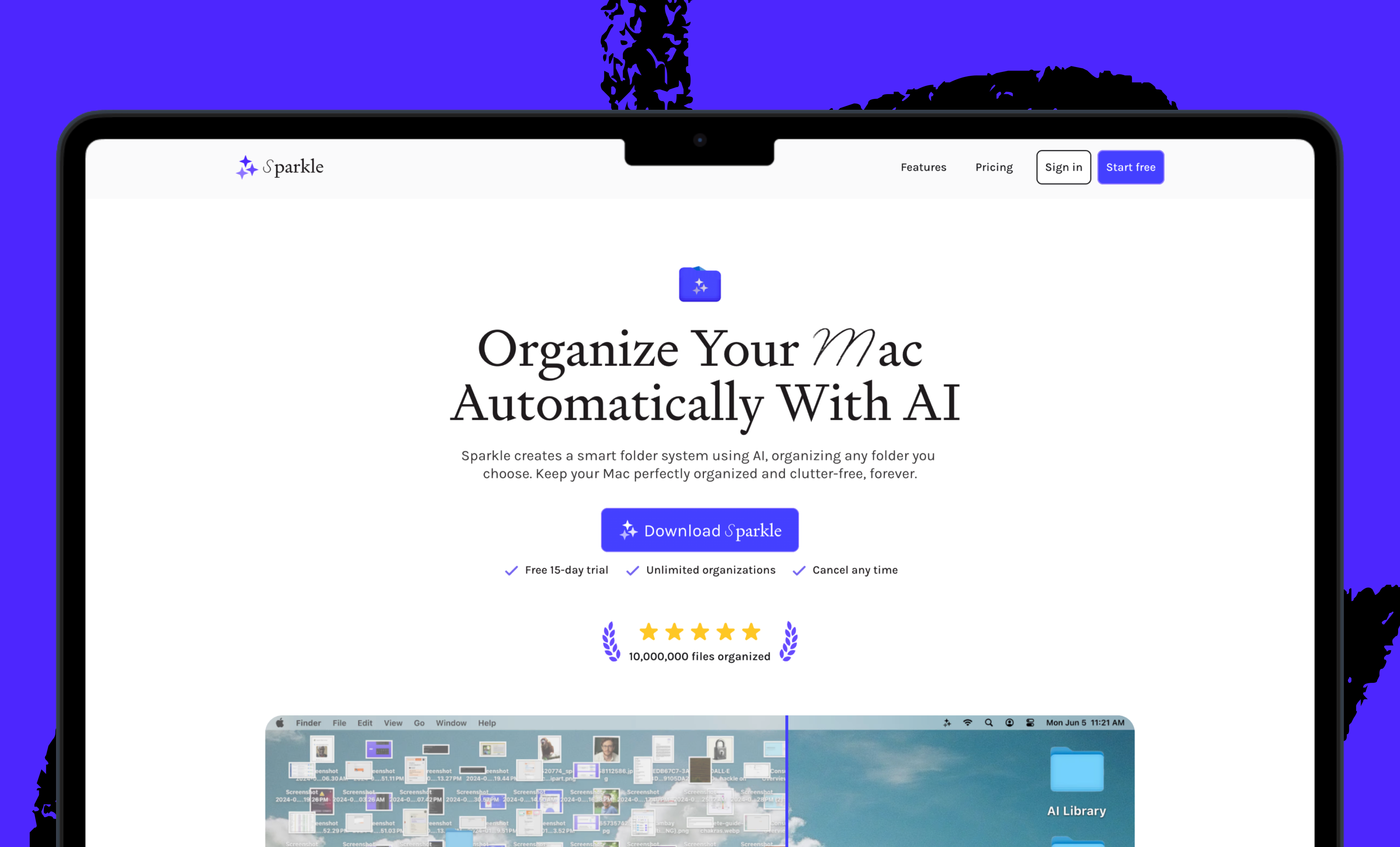
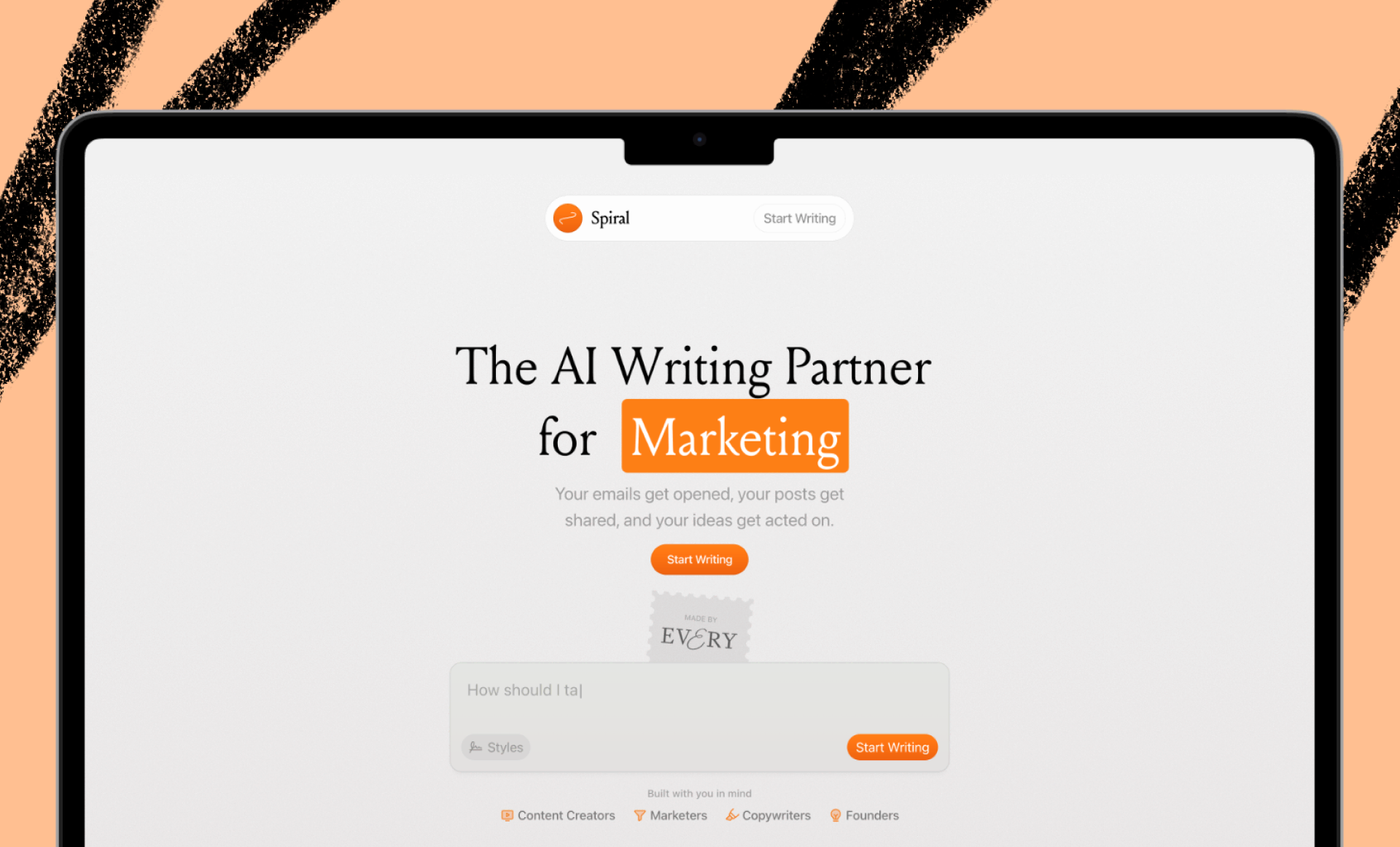

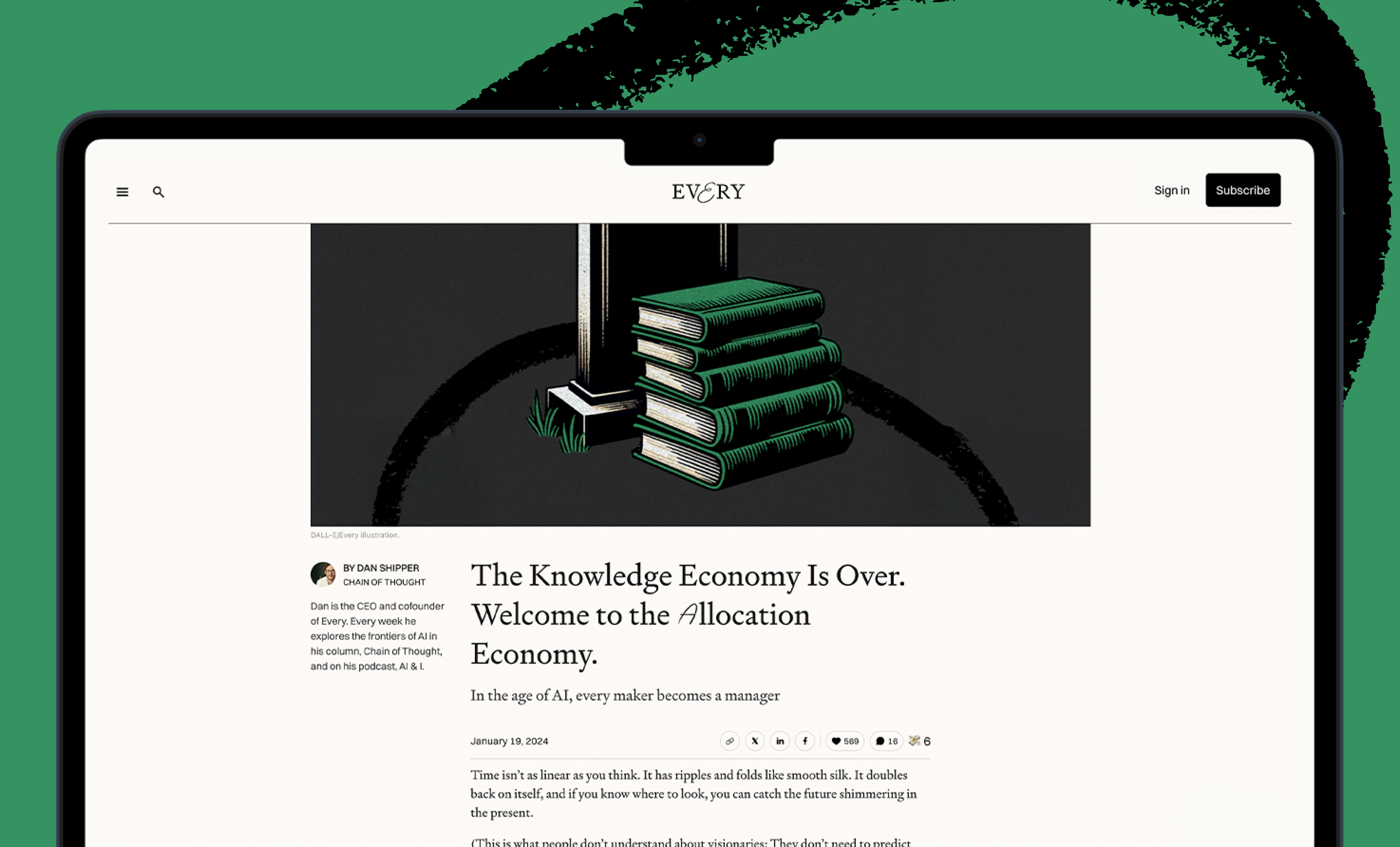
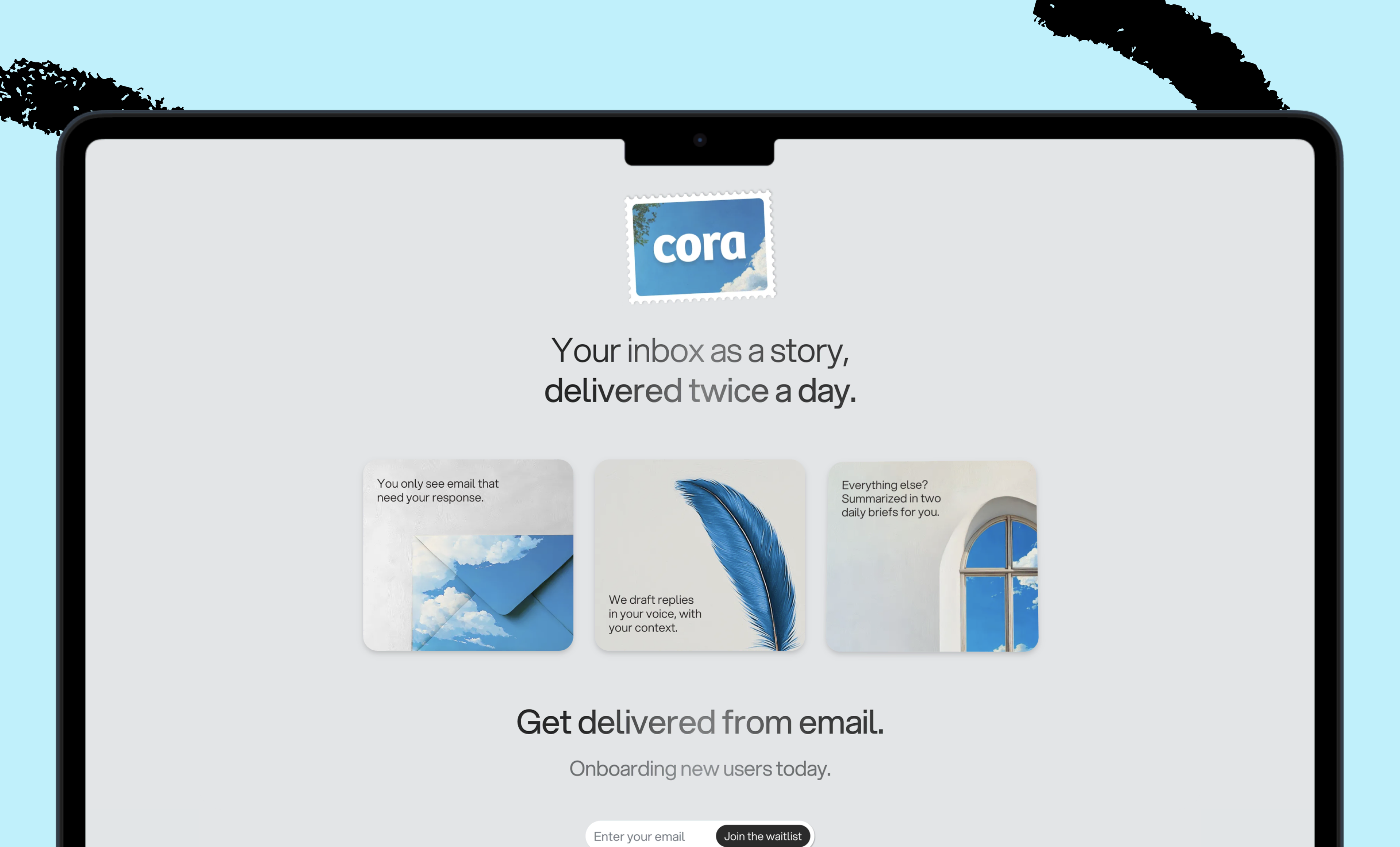
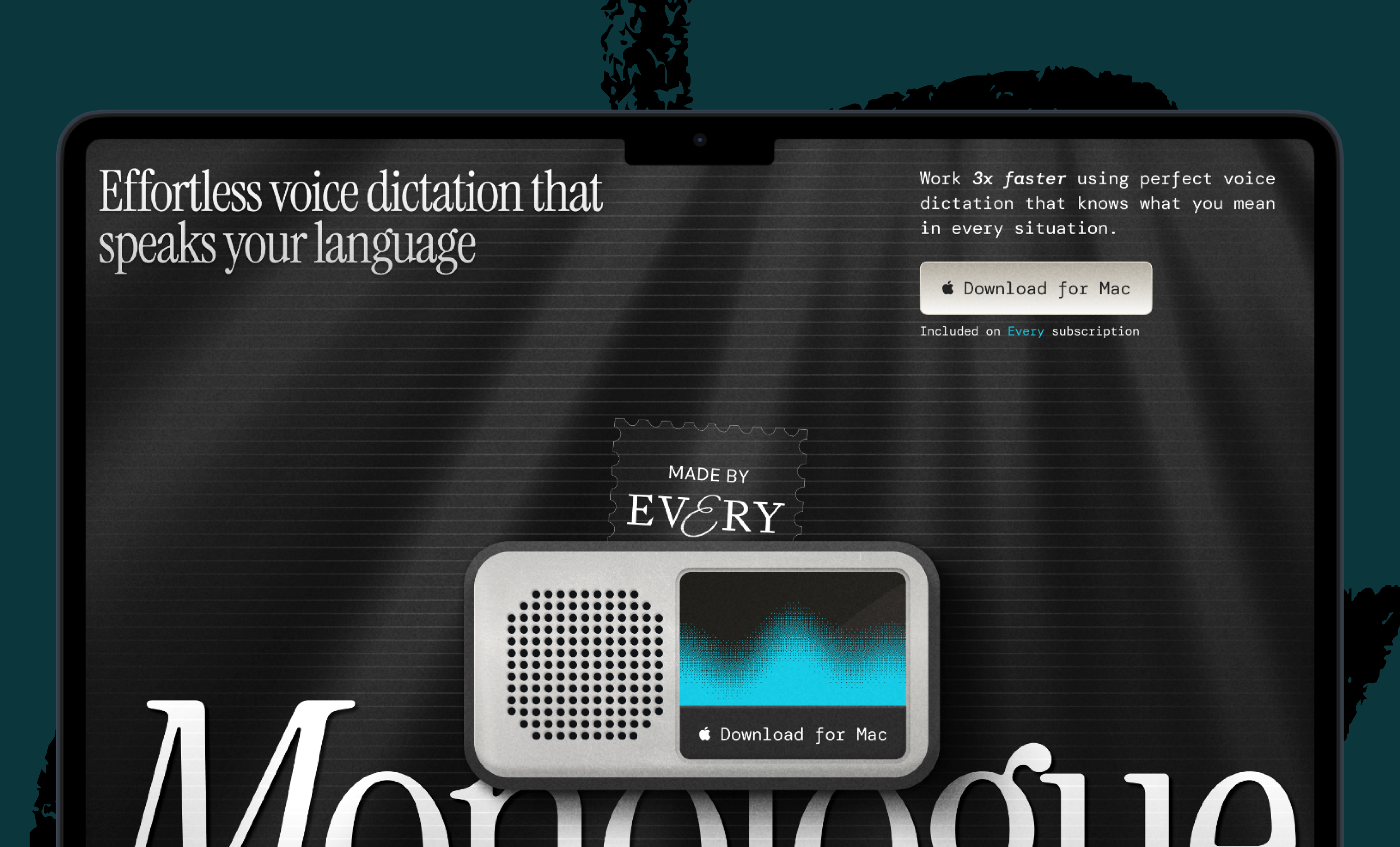


.31.48_AM.png)